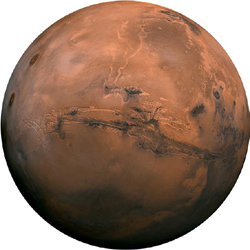Mars Geology
See also the history of human investigation of Mars.
Basic Facts

A global image of Mars' western hemisphere from Mars Global Surveyor data shows the north polar layered deposits (top), Valles Marineris surrounded by aphelion water ice clouds (below and right of center), and whitish orographic water ice clouds surrounding Tharsis Montes and Olympus Mons (left of center). (Credit: NASA/JPL/Malin Space Science Systems).
Bulk Properties
Radius: 3,396 kilometers (0.53 of Earth)
Density: 3.93 grams per cubic centimeter (71%of Earth)
Gravity: 0.38 of Earth
Mass: 0.11 of Earth
Two small moons: Phobos (Fear) and Deimos (Panic)
Orbit and Rotation
Rotates: 24 hours, 37 minutes
Elliptical Orbit 1.38 to 1.67 AU (1 AU = Earth-Sun distance)
Mars Year: 687 Earth days (669 Mars rotations, or sols)
Axis Inclined 25°, has seasons.
Climate
Surface Temperature: –129°C to 37°C (–199° F to 99° F)
Atmosphere about 0.6% pressure of Earth's, over 95% carbon dioxide with small amounts of argon, nitrogen, oxygen, carbon monoxide and water vapor
Polar caps of water and carbon dioxide ices
Winds are driven by seasonal heating and cooling; great dust storms occur near the closest point in Mars' orbit to the Sun (perihelion, during southern summer)
